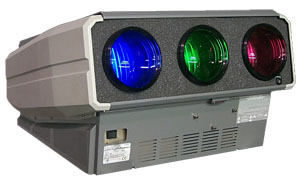 |
||||||||||||
| Home |
|
Products For Sale |
FAQs, Tips, Manuals |
Referral List |
|
Photo Gallery |
|
Links |
|
Contact Us |
|
|
||||||||||||||||||
HVPS Located behind the metal cover below the red tube, there are two types of HV power supplies. The older style used in the Marquee 8000 put out 34.0 kV. All later models put out 34.9 kV, and brought the tube brightness up by 200 lumens as a result, from 1000 to 1200.
For all intents and purposes, consider the HVPS to be a sealed unit that cannot be serviced. Most of the failures of the HVPS will occur without warning and the image will be lost. Half of the HVPS is a sealed silicone block which contains the high voltage parts. Most of the failures of the HVPS are within this silicone block and cannot be accessed, so the HVPS has to be replaced. On occasion there will be some arcing within the block, and the HV parts will slowly burn up. Once in a while these HV parts will arc to the metal chassis, and you will hear arcing or smell burning electronic parts. Again, this is not repairable, the HV supply needs to be replaced entirely. The accessible low voltage portion of the HVPS is accessible, but failure in this area is very rare, and required recalibration of the HV section if any parts are replaced in it. The HV supply is well protected however, and there are a number of situations that can make it look like the HV supply has failed when in actuality the set itself is causing the HV supply to shut down. These failures can be: - Bad CRT socket As stated before, there are a number of areas that are monitored in the projector for overload or failure conditions. Any abnormality in these areas and the HV supply will be shut down, and an error light may not be shown on the back CLM board. Component or board substitution is always the best way to check for unusual failures. HV ‘pulsing’. Another common HV problem is HV pulsing. This shows itself by the image coming on the screen, but then it quickly blooms out, and the picture is shut off when the HV shuts down. The HV then resets itself, starts to come up, senses the overload condition again, and shuts down again. This can happen anywhere from once a second to once every 4-5 seconds or so. Causes can be: - Shorted CRT Any of the above can cause this HV pulsing as all of the above components can cause too much HV current to be drawn by the tubes. If this occurs with your set, wait to pull the AC plug on the set until the HV is in shutdown mode, turning the set off when it’s at full brightness will almost always cause the phosphor on a tube to be spot burned. Internal arcing within the HVPS can also cause this pulsing condition, This can only be cured with replacement of the HVPS.
|
|
|||||||||||||||||
© Copyright CurtPalme.com. All Rights Reserved. |

 Electrohome Marquee
Series
Electrohome Marquee
Series
